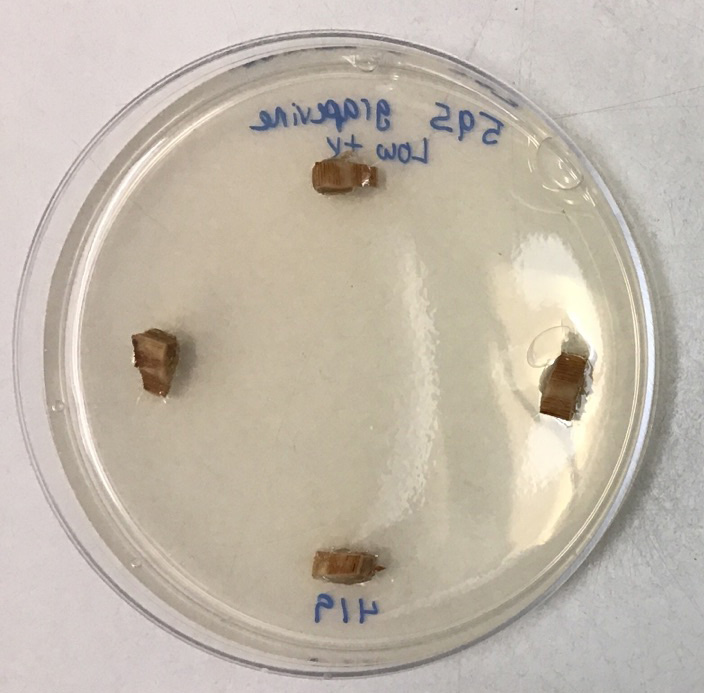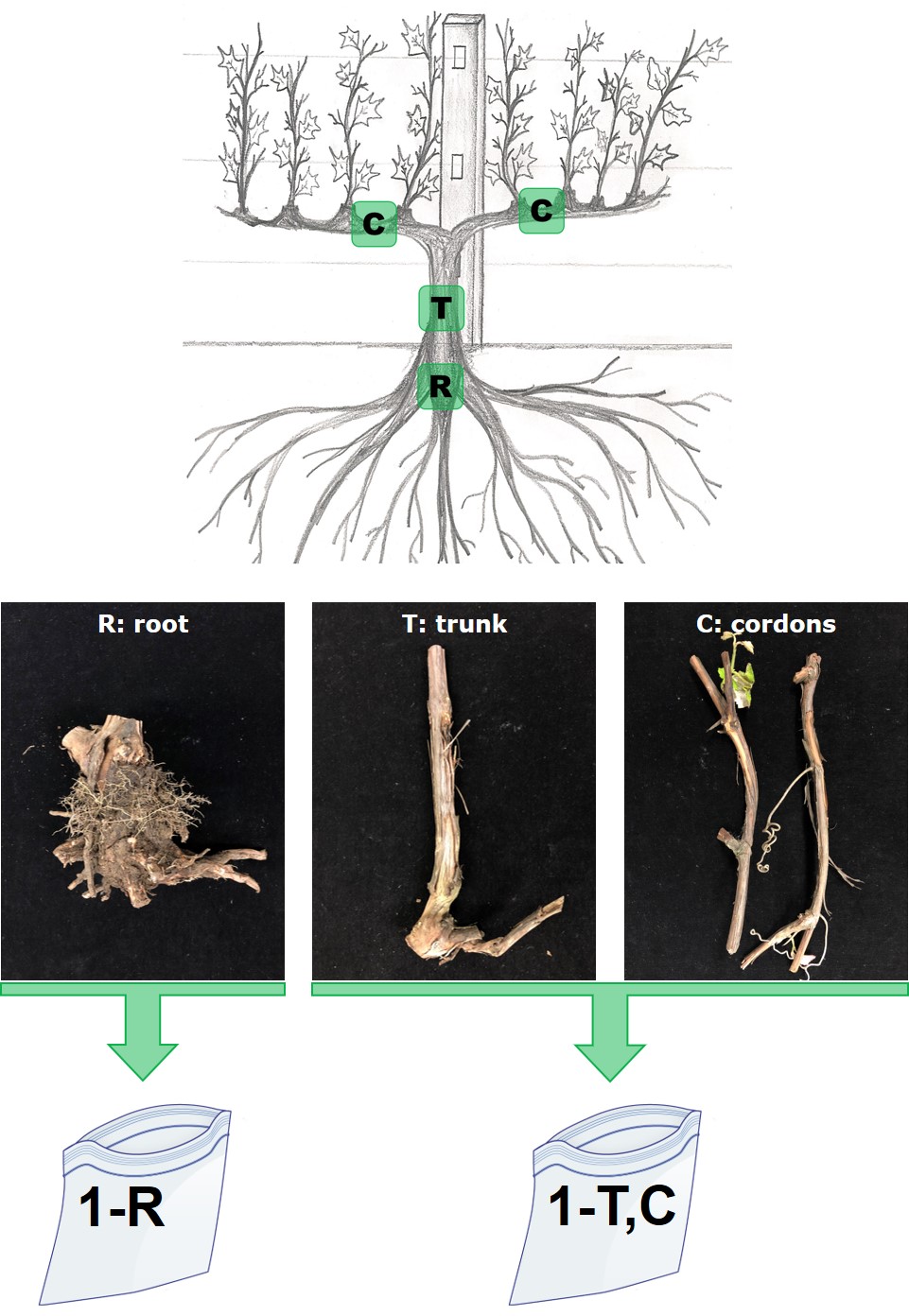Do you suspect grapevine trunk disease in your vineyard?
The only way to know for sure is by laboratory analysis. Learn how to submit a sample to MSU Plant & Pest Diagnostics for analysis.

Introduction
Grapevine trunk disease is a highly complex group of diseases caused by many different fungal pathogens. Considering that a single vine can be infected by more than one disease-causing organism, the expression of disease symptoms can be ambiguous and hard to distinguish. In fact, by the time external symptoms are observed, the vine may be already compromised. An infected vine not only interacts with these pathogens and its surrounding environment, but these pathogens can also interact with one another and these interactions are dependable on the grape cultivar. Very complex indeed!
Vines at risk
Every time a wound is produced, either in the nursery or in an established vineyard, the vine and its cuttings are in high risk of infection by fungal and bacterial pathogens. Currently, the most rigorous testing scheme designated as Protocol 2010 does not include any of the known grapevine trunk disease pathogens, which leaves growers dependable on nurseries’ good practices to maintain the clean status of certified propagation material. It is a great challenge, nonetheless, as clean plants can get infected during propagation and then at any stage after the material is planted.
The usual suspects
In young vineyards (less than seven years old), Petri disease (Fig. 1) and black foot are the two most common grapevine trunk diseases. In mature vineyards (more than eight years old), Eutypa dieback, Botryosphaeria dieback, Phomopsis dieback and Esca complex are widespread. Grapevine trunk disease pathogens are spread by air, rain droplets, arthropods and some can also be propagated through using infected cuttings.
GTD management
- Early prevention. It is critical to control grapevine trunk disease in a new vineyard. The best approach is to carefully inspect all planting material and any affected tissues in the vineyard once planted. Any symptomatic tissue should be inspected and tested by an experienced plant diagnostician to confirm grapevine trunk disease.
- Cultural practices. Keeping plants healthy will help vines be resistant to grapevine trunk disease. Things to consider would be: using healthy propagation materials, proper planting and avoiding over-cropping young vines.
- When you identify infected wood, cut it out at least 4 inches into healthy wood and properly dispose of it by burning or burying it to eliminate spore production. Remember to never prune during rainy, wet weather.
- Wound protection. Since most grapevine trunk diseases begin at wound sites, protecting these areas of the vine is important. Certain paints are available for use on grapevines to protect pruning cuts and other types of wounds from diseases. Also, dormant fungicide applications (e.g., Sulforix) will also protect these woods following pruning.
- Retraining vines. It is possible to rehabilitate diseased vines by renewing trunks and retraining new cordons, and training for multiple trunks and replace disease ones periodically.
Disease diagnosis

At MSU Plant & Pest Diagnostics, the identification of fungal pathogens causing trunk disease can be performed by a traditional laboratory technique called culturing. Culturing is a slow, labor-intensive practice that consist of placing small pieces of diseased tissue onto agar media (Fig. 2) that promotes growth of fungi living in the wood. Using this technique for accurate disease diagnosis depends on several factors:
- The quality of the submitted plant material.
- The pathogen’s ability to grow out of the plant tissue and onto the medium.
- The production of morphological structures that are visible and recognizable under a light microscope.
- Using molecular techniques for DNA-based identification, if such structures are not present.
Sampling a vine for grapevine trunk disease diagnosis
Please be aware that a sample submission requires destructive sampling.
The ideal sample consists of single-vine sections (10 to 12 inches long) taken from the main root, graft union (if present), trunk and cordons (Fig. 3).

Place all aboveground sections in a resealable plastic bag. When collecting a root section, shake-off excess soil and bag the plant material in a separate bag to prevent soil contamination; extra soil should not be included in the submission.
As you cut into the vine, select those sections with visible symptoms in the wood (for one example, see Fig. 1). However, make sure your selections are not completely dead (dark brown) as the recovery of grapevine trunk disease pathogens is restricted by the presence of fast-growing saprobes (organisms that live off of dead tissue).
Handling and shipping of samples
In the field and during transport, always keep samples inside a cooler with ice packs. We highly recommend submitting samples on the same day of collection; however, samples can be refrigerated for up to 48 hours. Please avoid shipping samples on Fridays as packages are not delivered to campus on weekends; samples will not arrive to the lab in good condition the following week.
Ship overnight (FedEx preferred) or deliver samples directly to our facility at:
MSU Plant & Pest Diagnostics
Att. Laura Miles
578 Wilson Road, CIPS 107
East Lansing, MI 48824
Testing fees
|
Description |
Fee per sample |
|---|---|
|
Plant health analysis |
$20 |
|
Fungal ID (sequencing) |
$30 |
Support provided by Project GREEEN and Michigan Department of Agriculture and Rural Development (MDARD) via the Michigan Craft Beverage Council.
Contact us for more information!
Email: lmiles@msu.edu
Phone: (517) 355-4536
Website: www.pestid.msu.edu



 Print
Print Email
Email
